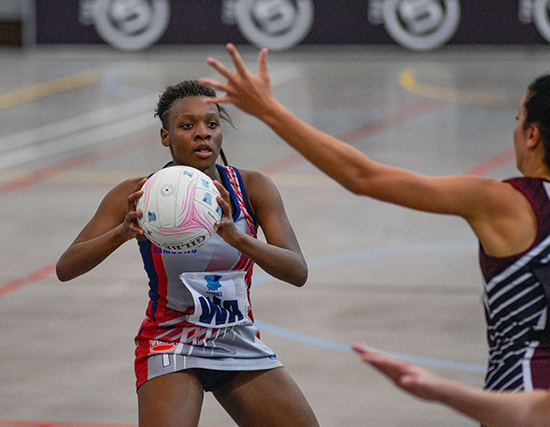Latest News Archive
Please select Category, Year, and then Month to display items
27 September 2018
Photo Varsity Sports
 Newly capped Protea Khanyisa Chawane will return for the Kovsies on Monday when they face the Maties in the semi-final of Varsity Netball in the Callie Human centre.
Newly capped Protea Khanyisa Chawane will return for the Kovsies on Monday when they face the Maties in the semi-final of Varsity Netball in the Callie Human centre.
A first ever Varsity Netball final in the Callie Human centre lie in what should the Kovsies cross the line this Monday in the semi-final against the Maties in Bloemfontein at 19:00.
Having ended first on the log, the Kovsies will enjoy home court advantage should they progress to the final on 8 October.
The Kovsies won their group fixture against the Maties last month in Stellenbosch by 59-56. It will be the first time the two teams clash in a knock-out match in the competition and also a first visit to the Callie Human centre for the Maties since 2013.
The Kovsies won six out of their seven group matches with their only loss against the Madibaz by a single goal.
They will be strengthened by the return of Khanyisa Chawane (centre) who missed a couple of matches whilst being in Australasia where she made her Protea debut. Meagan Roux, who can either play wing attack or goal attack, is also back. She travelled with the Proteas as a replacement.
They will however be without Tanya Mostert who will be on honeymoon. Her wedding is on Saturday. Remarkable it will only be the second time since her debut in the Kovsies’ very first match in the inaugural competition in 2013 that Mostert will miss a Varsity Netball match.
“The players really yearn to lift that trophy. It’s been some time since we last played in the final (in 2014). My message to them will be to give it their all on Monday,” Mostert said.
According to her the team is currently one that gels very nicely.
“Everyone fully understands their role in the team. We realized where our strengths lie and play according to it. Adding to that we play for one another.”
Expert in Africa Studies debunks African middle class myth
2016-05-10

From left: Prof Heidi Hudson, Director of the Centre for Africa Studies (CAS), Joe Besigye from the Institute of Reconciliation and Social Justice, and Prof Henning Melber, Extraordinary Professor at the CAS and guest lecturer for the day.
Photo: Valentino Ndaba
|
Until recently, think tanks from North America, the African Development Bank, United Nations Development Plan, and global economists have defined the African middle class based purely on monetary arithmetic. One of the claims made in the past is that anyone with a consumption power of $2 per day constitutes the middle class. Following this, if poverty is defined as monetary income below $1.5 a day, it means that it takes just half a dollar to reach the threshold considered as African middle class.
Prof Henning Melber highlighted the disparities in the notion of a growing African middle class in a guest lecture titled A critical anatomy of the African middle class(es), hosted by our Centre for Africa Studies (CAS) at the University of the Free State on 4 May 2016. He is an Extraordinary Professor at the Centre, as well as Senior Adviser and Director Emeritus of the Dag Hammarskjöld Foundation in Sweden.
Prof Melber argued that it is misleading to consider only income when identifying the middle class. In his opinion, such views were advanced by promoters of the global neo-liberal project. “My suspicion is that those who promote the middle class discourse in that way, based on such a low threshold, were desperate to look for the success story that testifies to Africa rising.”
Another pitfall of such a middle-class analysis is its ahistorical contextualisation. This economically-reduced notion of the class is a sheer distortion. Prof Melber advised analysts to take cognisance of factors, such as consumption patterns, lifestyle, and political affiliation, amongst others.
In his second lecture for the day, Prof Melber dealt withthe topic of: Namibia since independence: the limits to Liberation, painting the historical backdrop against which the country’s current government is consolidating its political hegemony. He highlighted examples of the limited transformation that has been achieved since Namibia’s independence in 1990.